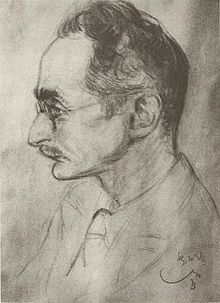Paul Maas (classical scholar)
You can help expand this article with text translated from the corresponding article in German. (May 2023) Click [show] for important translation instructions.
|

Paul Maas (18 November 1880, in
He studied
Research activity
His research interests lied mainly in textual criticism of Greek literature, poetry in particular.
Unlike most of his colleagues, he produced a relatively small number of
He also wrote extensively on Nonnus of Panopolis, although most of his conjectures and observations he never published and only wrote on the margins of the editions by Arthur Ludwich and Rudolf Keydell he owned.[5] A similar work he carried on Apollonius of Rhodes,[6] on Athenaeus[7] and on Herodotus.[8] Classical scholar Willy Theiler once observed that Maas's printed contributions to classical philology must be multiplied by ten, because most of Maas's reflections and thoughts were not published by him and still are.[9]
His most famous work is the "Textkritik" (1927), a concise theoretical handbook of textual criticism. It has been translated into many languages.[10] He also wrote a handbook of "Greek metre" (1923) and the handwritten notes for his unpublished "Byzantinische Metrik" have recently been discovered at Copenhagen.
His articles were collected by Wolfgang Buchwald in 1973.[11]
Maas's law
Maas formulated Maas's law, an observation of the layout of bookrolls.
Works by Maas published in English
- Textual criticism (1958), translation of Textkritik, 1927.[12]
- Greek metre (1962), translation of Griechische Metrik, 1923.[4]
Literature
- Katja Bär: Paul Maas. In: Robert B. Todd (Hrsg.): Dictionary of British Classicists Vol. 2. Bristol 2004.
- )
- ISBN 3-519-07435-4, S. 343–362.
- Hugh Lloyd-Jones: Paul Maas †. In: Gnomon 37, 1965, S. 219–221.
- Hugh Lloyd-Jones: Paul Maas (1880–1964). In: Eikasmós 4, 1993, S. 255–262. (Abstract)
- Eckart Mensching: Über einen verfolgten deutschen Altphilologen: Paul Maas 1880–1964. Berlin 1987.
- Peter Wirth (1987), "Maas, Paul", Neue Deutsche Biographie (in German), vol. 15, Berlin: Duncker & Humblot, pp. 597–597; (full text online)
References
- ^ "Paul Maas - stemmatology". wiki.uib.no. Archived from the original on 2014-04-13.
- ^ "Textual Scholarship: Stemmatics".
- ^ Kraatz - Menges / edited by Rudolf Vierhaus Deutsche Biographische Enzyklopaedie
- ^ ISBN 3-428-00196-6, S. 597.
- ^ Castelli, Carla (2023). "Sondaggi maasiani: postille e carteggi inediti sulle Dionisiache di Nonno tra le edizioni Ludwich e Keydell" (PDF). Commentaria Classica. 10: 255–272.
- ^ Pace, Nicola (2005). "Le postille di Paul Maas ad Apollonio Rodio". In Pretagostini, Roberto; Dettori, Emanuele (eds.). La cultura ellenistica. L'opera letteraria e l'esegesi antica. Atti del Convegno COFIN 2001, Università di Roma "Tor Vergata", 22-24 settembre 2003. Rome: Edizioni Quasar. pp. 437–450.
- JSTOR 20756785– via JSTOR.
- JSTOR 41616875– via JSTOR.
- JSTOR 27680885– via JSTOR.
- ^ E.g. Maas, Paul (1972) [1952]. Critica del testo. Translated by Martinelli, Nello. Con una presentazione di Giorgio Pasquali, lo Sguardo retrospettivo 1956 e una nota di Luciano Canfora (3 ed.). Firenze: Le Monnier. See also: Montanari, Elio (2003). La critica del testo secondo Paul Maas: testo e commento. Firenze: SISMEL—Edizioni del Galluzzo. Maas, Paul (2017). La critica del testo. Translated by Ziffer, Giorgio. Roma: Edizioni di Storia e Letteratura.
- ^ Maas, Paul (1973). Buchwald, Wolfgang (ed.). Kleine Schriften. München: Beck'sche Buchandlung.
- ^ Textual criticism OCLC WorldCat
